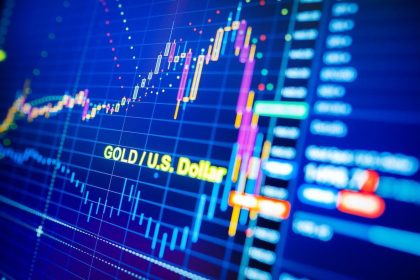Gold is the best known of the precious metals and also one of the most highly valued. When purchased, physical gold comes in many forms: coins, bars, or ingots of various sizes. It is also easy to store: because of its density and high price per ounce, you don’t need as much storage space to keep gold as you would for the same value of silver for example, let alone non-precious metals.
Physical gold has been used for thousands of years as a symbol of wealth and beauty before its run as a currency. Today, while it no longer serves as a currency or a divine symbol, it is widely used in manufacturing for electronics, technology, medicine, dentistry, glassmaking, and even space exploration. These specific uses and gold’s growing demand as an investment are what make it a highly desirable metal today.

When you buy physical gold, however, it is important to keep in mind the pros and cons as well as the different products available for purchase. Here is a shortlist of questions to ask yourself before buying:
- What are the advantages of physical gold?
- What are the risks of buying physical gold?
- How do I know which gold bars or coins to buy?
- What are the most popular gold products?
Now let’s try to answer those questions.
What are the advantages of physical gold?
Physical gold has many advantages thanks to its long history and nature as a savings and investment product. Let’s see some of them.
Gold as a store of value
Unlike paper currencies or many other assets, gold tends to maintain its value, or even appreciate, over the long term. This is why it has always been considered an excellent way to pass on and preserve wealth from one generation to the next.

Gold as a safe haven
Gold has historically served as a safe haven asset, meaning that investors turn to gold when an economic situation might threaten their other investments, for example. This is particularly the case during periods of inflation or deflation.

In times of inflation: Over the past 50 years, investors have seen gold prices soar and the stock market plunge during years of high inflation. Indeed, when rising inflation drives up prices and lowers the purchasing power of paper currencies, because gold is still measured using these same currencies, it often sees its price rise along with everything else. This is why gold has historically been considered a good store of value to turn to during periods of inflation.
In times of deflation: On the contrary, when prices fall, business activity slows and the economy is often burdened by excessive debt, low prices, and high risk, factors that have made the relative purchasing power of gold soar in the past.
Gold as a hedge against uncertainty
In times of market volatility: When markets become too volatile, investors tend to look for safer assets to counterbalance the risk they might take elsewhere. They often turn to gold, a historically stable asset in the long-term that has shown to be negatively correlated to the stock market.

In times of geopolitical turmoil: Gold is considered a “crisis commodity” capable of retaining its value in times of national or international crisis. This historic safe haven is seen as a product of choice by investors when global tensions escalate, with gold often outperforming other investments.
In addition to these historical qualities as a safe haven, a store of value, and a protection against inflation, deflation, as well as economic and geopolitical turmoil, gold has other unique features.
- Gold is a standard with a rich history: as it used to be the actual “gold standard” for currencies, it has remained an important store of value throughout our history which makes it a reliable investment asset.
- Physical gold has intrinsic value: its physical value is based on tangible factors such as purity, rarity, attractiveness, and utility, which also reinforce its stability and overall value.
- Physical gold has no default risk: Unlike paper assets (ETFs…), gold is a physical asset that can be fully allocated and stored outside the banking system. In which case, there is no risk that someone will refuse or become unable to pay for or give you back your gold, since you already own it.
- Gold is seen as a safe asset: Physical gold is often seen as a safe investment, especially in times of market volatility. Unlike other assets that may go up and down in price during these periods, physical gold tends to appreciate slowly over the long term.
- Physical gold is an accessible commodity: With a globalized market, buying physical gold is an easy way to include commodities in your investment portfolio. Its wide range of products, going from 1 gram to several kilos also makes it an accessible asset for all budgets.
- Gold is a liquid investment: With a large globalized and highly liquid market, gold is a very easy asset to buy or sell when needed.
- Gold tends to increase in value over the long term: In addition to being an investment asset, physical gold is also a consumer good. Thus, while it can experience short-term fluctuations, it also tends to retain its value over the long term, both in periods of global economic turmoil and growth.
Of course, buying physical gold can also carry risks that are important to understand in order to make sure you can avoid them.
What are the risks of buying physical gold?
Like with any investment, buying physical gold can bear risks. However, by taking the time to understand these risks, it is possible to prevent them and better protect yourself.

Here are the 3 main risks of buying physical gold:
- The hidden costs of physical gold
- The risks and costs of storing physical gold
- The volatility of the gold price
What are the costs associated with buying and reselling physical gold?
Before making your gold purchase, it is important to make sure you are dealing with a reliable and transparent reseller. Some well-established websites exist to check on the reputation of most online and physical gold sellers, so always make sure that the reseller you are buying from is a reliable and recognized player in the industry. If they seem to lack transparency on prices or on the fees associated with your purchase, walk away. A reputable seller will always inform you in full transparency of the total price and possible fees associated with any purchase.
And when comes the time to resell, fees also tend to be complex and hard to find, with some resellers charging significant commissions. Physical stores, for example, tend to apply complex rates that are often difficult to compare between stores. Online solutions tend to be more advantageous, but the issue of reliability also comes into play. This is why it is important that, before buying, you think about how you will resell your physical gold.
Risks and costs of storing physical gold
No matter how much physical gold you own, storing it securely can quickly become a significant cost. While storing it at home often seems like the most obvious and cheapest solution, it is also the most exposed to theft and damage (fire, loss, etc.), and often the most expensive, as you will need to invest in a personal safe as well as insurance to cover yourself against those risks.

Choosing for a bank safe can be a more secure solution but remains expensive in terms of insurance and complex fees to calculate. Moreover, storing your gold in a bank exposes it to counterparty risk in the event of bankruptcy from your bank for example. It is therefore important to take these “hidden” costs into account before making your choice. Finally, not all storage solutions offer an easy solution to manage your gold and thus some will force customers to physically go to their vaults or safe deposit box to manage their inventory. If it is not directly located close to your home, you will also have to take into account the cost and time it will take to access your physical gold.
Gold price volatility
Is the price of gold volatile? While the COVID-19 pandemic seems to have made somewhat of a case for this argument, it has not historically been the case, as the price of gold does not work in the same way as the stock market. Indeed, buying physical gold is commonly seen as a long-term investment. While some buyers will seek to play on the volatility of its price in the short term to make a profit, most are looking for a safe haven that will work for them as a way to preserve the value of their capital over the long term.
The price of physical gold, like any other investment, does experience some level of volatility, but the advantage of buying gold over stocks or bonds is its historical ability to preserve the value of your investment over the long term.
Which gold bars or coins to buy?
Once you’ve considered the risks, you’ll need to decide which products you want to buy. Obviously, the final choice of product will depend on your buying strategy, your budget, and your personal taste. Some buyers will prefer to buy “minted” ingots in part because of their unique design, while others will opt for “cast” ingots, often in larger quantities, to get the best price.
For those investing in physical gold to diversify their portfolio, buying ingots is a common choice. Gold ingots are priced based on their weight in troy ounce (oz), where 1 troy ounce is equal to 31.1 grams of pure gold. Of course, the price of each ingot will vary depending on when you make your purchase. This is because the spot price (the current price on the market) is constantly updated throughout the day, depending on the supply and demand in the market.
Investors who turn to gold bars are often looking, in parts, for a better value than they would maybe get with coins. The complexity of minting gold coins often add a small premium to their price, so those who buy gold just to invest and get the best price, sometimes tend to turn to bars first.

What are the most popular gold products?
The most popular products are cast and minted bars, and coins. But not all are equally popular with all buyers. While some collectors will often prefer to also buy coins, others will seek to diversify their investment portfolio by focusing mainly on cast bars.

Physical gold cast and minted bars are often chosen by those looking to buy gold at the best price. Indeed, it is on bars, especially cast bars, i.e. bars simply created by “casting” a mass of pure gold in a mold, that the premium (the part of the price taken by the seller) will often be the lowest.
The other type of ingots, called minted bars, require more elaborate craftsmanship, which, in turn, will make them more valuable. These higher production costs generally translate into a slightly higher premium. Nevertheless, they remain very popular products, not only for their beauty but also for their ability to potentially increase in value over time. This is particularly true of the famous PAMP’s Lady Fortuna minted bar range.

When it comes to gold bars, each country seems to have its preferred sizes and finishes.
Finally, gold coins are also very popular products. They have the particularity of being popular as both collectible and investment products. The most popular coins are investment coins such as the Kruggerand from South Africa or the American Eagle from the United States, as well as classic coins such as the Swiss Vreneli or the French 20 francs Napoleon.
Some of these coins are sometimes issued in limited edition to celebrate a date, an event, or a national or international personality. These limited editions are often very popular, especially with collectors and connoisseurs who expect them to gain value over time due to their rarity.

The most popular products will then vary by country and even by city. Each country tend to have a preference for its national coins: the Vreneli in Switzerland, the American Eagle in the United States, the Maple Leaf in Canada, the Britannia in the United Kingdom, the Napoleon in France, or the Vienna Philharmonic in Austria. Although these are also widely traded coins around the world.
Gold Lesson 1: Introduction to Gold








